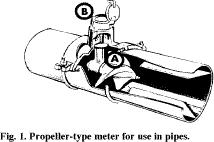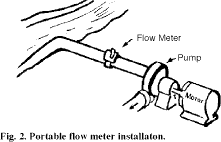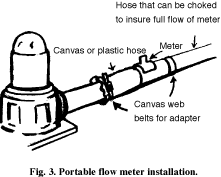Guide A-102
C.M. Hohn,
College of Agricultural, Consumer and Environmental Science, New Mexico State University
Author: Extension Agricultural Engineer, New Mexico State University (Print Friendly PDF)
Flow meters are excellent devices for measuring flow in an irrigation pipe. A typical flow meter is shown in the cutaway view, fig. 1. The main parts consist of a propeller (A) mounted in a short section of pipe and geared to a revolution counter (B) which records the rate of flow and the cumulative total. The counter is similar to an automobile speedometer, which shows both the rate of speed of the car as well as the miles traveled.

Fig. 1. Propeller-type meter for use in pipes.
The principle of operation of the flow meter is simple. The speed of the flow is measured by the water turning the propeller as it passes by, and the area is determined from the size of the pipe. The dial of the meter then reads directly in gallons or cubic feet of flow. Rates of flow such as gallons per minute or cubic feet per second are then obtained by simply noting the rate of flow on the dial for any given length of time as measured by a watch.
Since the flow meter works on the principle of a given rate of flow through a fixed area of pipe, the pipe must be flowing full for accurate results. Install the flow meter in the pipe about eight pipe diameters away from any bends, elbows, or turbulence-causing fittings on the upstream side.
Select the proper size of flow meter for the anticipated rate of flow. Meter sizes are generally classified by the diameter of the pipe in which they are mounted. They range generally from 4 inches to 72 inches in standard production.
A few available sizes and their normal range of flow are:
| Size | Normal Range GPM |
| 4" | 60-400 |
| 6" | 100-900 |
| 8" | 120-1,200 |
| 10" | 160-1,600 |
| 12" | 200-2,000 |
| 4" | 1260-2,500 |
| 16" | 280-3,500 |
| 18" | 400-4,500 |
Flow meters are the most convenient devices for measuring flow in pipes. They are more expensive than other measuring devices. Prices range from about $200 for a small one to over $1,000 for a large size. Flow meters require very little maintenance and are usually accurate to within two percent.
You can install flow meters permanently in a pipeline (fig. 2) or make them portable with canvas or plastic hoses to clamp over a well stub to measure flow (fig. 3).

Fig. 2. Portable flow meter installation.

Fig. 3. Portable flow meter installation.
To find more resources for your business, home, or family, visit the College of Agricultural, Consumer and Environmental Sciences on the World Wide Web at pubs.nmsu.edu
Contents of publications may be freely reproduced for educational purposes. All other rights reserved. For permission to use publications for other purposes, contact pubs@nmsu.edu or the authors listed on the publication.
New Mexico State University is an equal opportunity/affirmative action employer and educator. NMSU and the U.S. Department of Agriculture cooperating.
September 1997, Las Cruces, New Mexico


